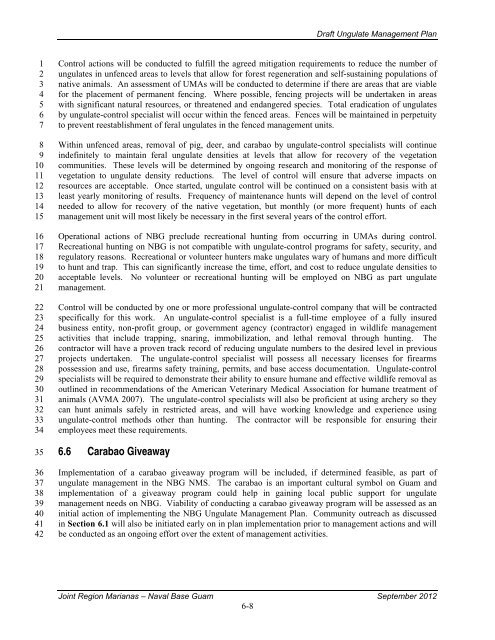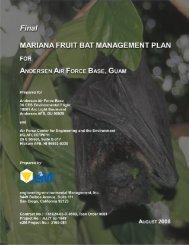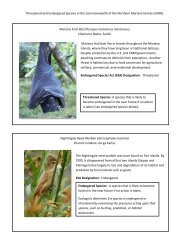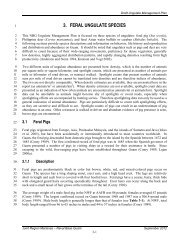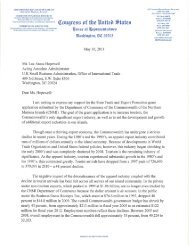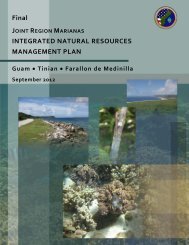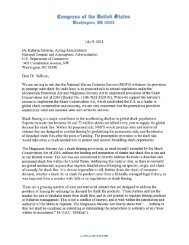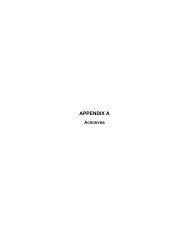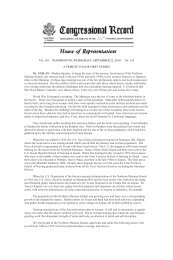4. FERAL UNGULATE SPECIES IMPACTS ON NAVY LANDS
4. FERAL UNGULATE SPECIES IMPACTS ON NAVY LANDS
4. FERAL UNGULATE SPECIES IMPACTS ON NAVY LANDS
Create successful ePaper yourself
Turn your PDF publications into a flip-book with our unique Google optimized e-Paper software.
1<br />
2<br />
3<br />
4<br />
5<br />
6<br />
7<br />
8<br />
9<br />
10<br />
11<br />
12<br />
13<br />
14<br />
15<br />
16<br />
17<br />
18<br />
19<br />
20<br />
21<br />
22<br />
23<br />
24<br />
25<br />
26<br />
27<br />
28<br />
29<br />
30<br />
31<br />
32<br />
33<br />
34<br />
35<br />
36<br />
37<br />
38<br />
39<br />
40<br />
41<br />
42<br />
Draft Ungulate Management Plan<br />
Control actions will be conducted to fulfill the agreed mitigation requirements to reduce the number of<br />
ungulates in unfenced areas to levels that allow for forest regeneration and self-sustaining populations of<br />
native animals. An assessment of UMAs will be conducted to determine if there are areas that are viable<br />
for the placement of permanent fencing. Where possible, fencing projects will be undertaken in areas<br />
with significant natural resources, or threatened and endangered species. Total eradication of ungulates<br />
by ungulate-control specialist will occur within the fenced areas. Fences will be maintained in perpetuity<br />
to prevent reestablishment of feral ungulates in the fenced management units.<br />
Within unfenced areas, removal of pig, deer, and carabao by ungulate-control specialists will continue<br />
indefinitely to maintain feral ungulate densities at levels that allow for recovery of the vegetation<br />
communities. These levels will be determined by ongoing research and monitoring of the response of<br />
vegetation to ungulate density reductions. The level of control will ensure that adverse impacts on<br />
resources are acceptable. Once started, ungulate control will be continued on a consistent basis with at<br />
least yearly monitoring of results. Frequency of maintenance hunts will depend on the level of control<br />
needed to allow for recovery of the native vegetation, but monthly (or more frequent) hunts of each<br />
management unit will most likely be necessary in the first several years of the control effort.<br />
Operational actions of NBG preclude recreational hunting from occurring in UMAs during control.<br />
Recreational hunting on NBG is not compatible with ungulate-control programs for safety, security, and<br />
regulatory reasons. Recreational or volunteer hunters make ungulates wary of humans and more difficult<br />
to hunt and trap. This can significantly increase the time, effort, and cost to reduce ungulate densities to<br />
acceptable levels. No volunteer or recreational hunting will be employed on NBG as part ungulate<br />
management.<br />
Control will be conducted by one or more professional ungulate-control company that will be contracted<br />
specifically for this work. An ungulate-control specialist is a full-time employee of a fully insured<br />
business entity, non-profit group, or government agency (contractor) engaged in wildlife management<br />
activities that include trapping, snaring, immobilization, and lethal removal through hunting. The<br />
contractor will have a proven track record of reducing ungulate numbers to the desired level in previous<br />
projects undertaken. The ungulate-control specialist will possess all necessary licenses for firearms<br />
possession and use, firearms safety training, permits, and base access documentation. Ungulate-control<br />
specialists will be required to demonstrate their ability to ensure humane and effective wildlife removal as<br />
outlined in recommendations of the American Veterinary Medical Association for humane treatment of<br />
animals (AVMA 2007). The ungulate-control specialists will also be proficient at using archery so they<br />
can hunt animals safely in restricted areas, and will have working knowledge and experience using<br />
ungulate-control methods other than hunting. The contractor will be responsible for ensuring their<br />
employees meet these requirements.<br />
6.6 Carabao Giveaway<br />
Implementation of a carabao giveaway program will be included, if determined feasible, as part of<br />
ungulate management in the NBG NMS. The carabao is an important cultural symbol on Guam and<br />
implementation of a giveaway program could help in gaining local public support for ungulate<br />
management needs on NBG. Viability of conducting a carabao giveaway program will be assessed as an<br />
initial action of implementing the NBG Ungulate Management Plan. Community outreach as discussed<br />
in Section 6.1 will also be initiated early on in plan implementation prior to management actions and will<br />
be conducted as an ongoing effort over the extent of management activities.<br />
Joint Region Marianas – Naval Base Guam September 2012<br />
6-8


